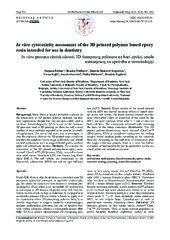Приказ основних података о документу
In vitro cytotoxicity assessment of the 3D printed polymer based epoxy resin intended for use in dentistry
In vitro procena citotoksičnosti 3D štampanog polimera na bazi epoksi smole namenjenog za upotrebu u stomatologiji
| dc.creator | Puškar, Tatjana | |
| dc.creator | Trifković, Branka | |
| dc.creator | Đurović-Koprivica, Daniela | |
| dc.creator | Kojić, Vesna | |
| dc.creator | Jevremović, Ana | |
| dc.creator | Mirković, Siniša | |
| dc.creator | Eggbeer, Dominic | |
| dc.date.accessioned | 2020-07-02T13:25:37Z | |
| dc.date.available | 2020-07-02T13:25:37Z | |
| dc.date.issued | 2019 | |
| dc.identifier.issn | 0042-8450 | |
| dc.identifier.uri | https://smile.stomf.bg.ac.rs/handle/123456789/2446 | |
| dc.description.abstract | Background/Aim. There is limited published evidence on the cytotoxicity of 3D printed polymer materials for dentistry applications, despite that they are now widely used in medicine. Stereolithography (SLA) is one of the foremost 3D processes used in 3D printing, yet there are only a small number of resin materials reported to be suitable for medical applications. The aim of this study was to investigate, in vitro, the cytotoxic effect of the 3D printed resin in order to establish the suitability for its usage in dentistry and related medical applications such as surgical dental guides, occlusal splits and orthodontic devices. Methods. To examine the cytotoxicity of the 3D printed polymer-based epoxy resin, Accura® ClearVue™ (3D-Systems, USA), two cell cultures were used: mouse fibroblasts L929, and human lung fibroblasts MRC-5. The cell viability was determined by the Mosmann's colorimetric (MTT) test and the agar diffusion test (ADT). Results. Direct contact of the tested material with the ADT test showed nontoxic effects of tested material in any cell culture. The tested material showed no cytotoxic effect after 3 days of extraction of the eluate by the MTT, but mild cytotoxic effect after 5, 7 and 21 days on both cell lines. The cytotoxicity increased with increasing the time of the eluate extraction. Conclusion. The 3D printed polymer-based epoxy resin, Accura® ClearVue™ (3D-Systems, USA) is considered appropriate for making surgical dental implant guides according to the cytotoxic behavior. According to the mild level of cytotoxicity after the longer extraction periods, there is a need for further evaluation of biocompatibility for its application for the occlusal splints and orthodontic devices. | en |
| dc.description.abstract | Uvod/Cilj. Malo je objavljenih dokaza o citotoksičnosti 3D štampanih polimernih materijala za upotrebu u stomatologiji, bez obzira na njihovu sve širu primenu u medicini. Stereolitografija (SLA) jedan je od najvažnijih 3D procesa koji se primenjuje za 3D štampu, ali postoji samo Mali broj materijala na bazi smola za koje je dokazano da su pogodni za medicinsku primenu. Cilj ove studije je bio da se ispita, in vitro, citotoksični efekat 3D štampanog polimera kako bi se utvrdila mogućnost za njegovu upotrebu u stomatologiji i srodnim medicinskim oblastima, kao što su hirurške dentalne vođice, okluzalni splintovi i ortodontski aparati. Metode. Da bi se ispitala citotoksičnost 3D štampanog polimera na bazi epoksi smole, Accura® ClearVue ™ (3D-Sistems, USA), korišc'ene su dve c'elijske kulture: fibroblasti miša L929 i humani fibroplasti pluc'a MRC-5. Vijabilnost c'elija utvrđena je Mosmannovim kolorimetrijskim testom (MTT) i testom difuzije agara (ADT). Rezultati. Direktan kontakt testiranog materijala ispitan pomoću ADT pokazao je da materijal nije imao citotoksičan efekat ni na jednu ćelijsku kulturu. Testitrani materijal je imao blag citotoksični efekat posle 5, 7 i 21 dana ekstrakcije eluata primenom MTT na obe ćelijske linije. Citotoksičnost je rasla sa produženjem vremena ekstrakcije eluata. Zaključak. 3D štampani polimer na bazi epoksi smole, Accura® ClearVue ™ (3D-Sistems, USA) se može smatrati pogodnim za izradu hirurških dentalnih implantnih vođica sa tačke gledišta njegovog citotoksičnog uticaja. Zbog pokazanih blagih citotoksičnih efekata nakon dužih ekstrakcionih perioda eluata potrebna su dalja istraživanja u oblasti biokompatibilnosti materijala da bi se taj polimer mogao koristiti za izradu okluzalnih splintova i ortodontskih aparata. | sr |
| dc.publisher | Vojnomedicinska akademija - Institut za naučne informacije, Beograd | |
| dc.relation | info:eu-repo/grantAgreement/MESTD/Technological Development (TD or TR)/35020/RS// | |
| dc.relation | No. 114-451-2723/2016-03 "Improving the treatment of diseases of dental system through the development of modern diagnostic methods for the detection of occlusal loading",funded by the Provincial Secr for Science and Tech Dev Vojvodina | |
| dc.rights | openAccess | |
| dc.rights.uri | https://creativecommons.org/licenses/by-sa/4.0/ | |
| dc.source | Vojnosanitetski pregled | |
| dc.subject | cell culture techniques | en |
| dc.subject | dental materials | en |
| dc.subject | epoxy resin | en |
| dc.subject | material testing | en |
| dc.subject | printing, three-dimensional | en |
| dc.subject | three-dimensional | en |
| dc.subject | ćelije, kultura | sr |
| dc.subject | stomatološki materijali | sr |
| dc.subject | smole, sintetičke | sr |
| dc.subject | materijali, testiranje | sr |
| dc.subject | štampanje, trodimenzionalno | sr |
| dc.title | In vitro cytotoxicity assessment of the 3D printed polymer based epoxy resin intended for use in dentistry | en |
| dc.title | In vitro procena citotoksičnosti 3D štampanog polimera na bazi epoksi smole namenjenog za upotrebu u stomatologiji | sr |
| dc.type | article | |
| dc.rights.license | BY-SA | |
| dcterms.abstract | Еггбеер, Доминиц; Мирковић, Синиша; Јевремовић, Aна; Ђуровић-Копривица, Даниела; Пушкар, Татјана; Трифковић, Бранка; Којић, Весна; Ин витро процена цитотоксичности 3Д штампаног полимера на бази епокси смоле намењеног за употребу у стоматологији; Ин витро процена цитотоксичности 3Д штампаног полимера на бази епокси смоле намењеног за употребу у стоматологији; | |
| dc.citation.volume | 76 | |
| dc.citation.issue | 5 | |
| dc.citation.spage | 502 | |
| dc.citation.epage | 509 | |
| dc.citation.other | 76(5): 502-509 | |
| dc.citation.rank | M23 | |
| dc.identifier.wos | 000504433600006 | |
| dc.identifier.doi | 10.2298/VSP170721127P | |
| dc.identifier.scopus | 2-s2.0-85069711775 | |
| dc.identifier.fulltext | https://smile.stomf.bg.ac.rs/bitstream/id/974/2441.pdf | |
| dc.type.version | publishedVersion |


